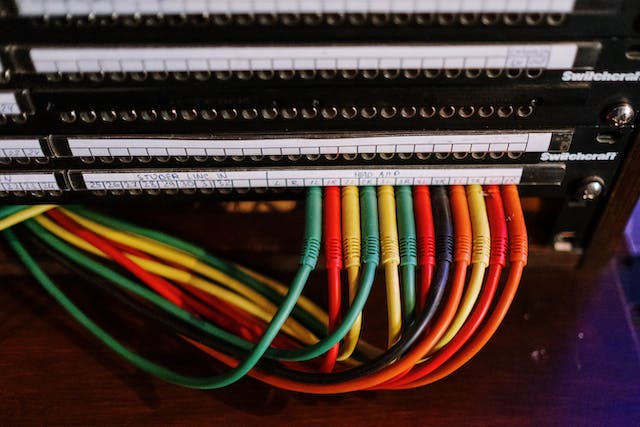Patch panels are the unsung heroes of the complex world of networking, where they provide the vital function of coordinating data transport across your system. Patch panels are essential for more than just managing cables; they help with connection optimization, efficiency, and setting the groundwork for a reliable, scalable network. Let’s examine the crucial role patch panels play in the complex dance of data transfer.
1. Centralized Connectivity Hub: The Nexus of Network Organization
The patch panel, which serves as the main connecting hub that provides order to the disarray of wires, is the focal point of a well-organized network. Think of it as the hub of your network, where wires coming from many places come together to form a neat, organized structure. The patch panel acts as a bridge between the many devices connected to your network and your active equipment, such as switches and routers. When there are frequent additions and modifications, a patch panel’s organizing skill is most apparent. Rather than navigating a disorganized jumble of wires directly attached to networking hardware, the patch panel offers an organized, clearly marked layout.
2. Facilitating Rapid Troubleshooting: A Lifeline for Network Maintenance
In the ever-changing world of networking, problems are unavoidable. It is essential to be able to quickly detect and resolve problems related to new device integration, broken connections, or cables that need to be replaced. At this point, the patch panel turns into an indispensable tool for network maintenance. Every port on a patch panel is associated with a particular cable, and these ports are often labeled or color-coded to make identification simple. If a problem occurs, you can track it down to the exact port on the patch panel, saving you the trouble of sifting through a maze of wires that are directly attached to your operating equipment.
3. Scalability and Future-Proofing: Adapting to Growing Demands
Scalability in the ever-changing world of technology is not a luxury but rather a need. In order for your network to be able to adjust to the increasing needs of data transmission and device integration, patch panels are essential. Patch panels’ organized and modular architecture makes it simple to expand and modify them without causing the network as a whole to malfunction. You may easily incorporate more cables and activate more ports on the patch panel as your network grows. Your network will be future-proof because of its scalability, which also offers an affordable way to handle the growing number of devices and data traffic.
4. Cable Management: Mitigating Chaos, Enhancing Aesthetics
Cable organization is one of the most important but sometimes disregarded areas of network administration, and patch panels come in handy here. Fiber optic patch cable panels‘ organized design, together with their well-labeled and ordered connections, completely changes the way your networking infrastructure looks. In addition to being aesthetically pleasing, good cable management is essential for minimizing signal interference and lowering the possibility of cable damage. With a specific location for every cable, the patch panel acts as the hub for cable management.
5. Flexibility in Network Configuration: Tailoring Connectivity to Your Needs
In the ever-changing world of networking, adaptability is essential. Patch panels are a flexible option that lets you customize your network setup to fit certain requirements. Whether you are rearranging office spaces or installing new technologies that need a different network configuration, the patch panel offers the flexibility you need to quickly adjust connections. Patch panels’ modular architecture allows for simple cable replacement or rearranging without affecting the network as a whole.
6. Enhanced Network Performance: Minimizing Signal Loss, Maximizing Efficiency
Network performance is largely dependent on data transmission efficiency, which patch panels greatly enhance. Patch panels enable connections that reduce signal loss, guaranteeing that data is sent with the least amount of attenuation possible from its source to its destination. Patch panels provide a regulated and organized environment that lowers the possibility of electromagnetic noise and signal interference, enhancing the overall dependability and effectiveness of your network. Patch panels are essential for preserving steady data transfer rates, cutting latency, and enhancing your network’s overall performance since they mitigate signal loss.
Conclusion
Patch panels play the role of connection architects in the complex symphony of networking, coordinating the smooth movement of data across your system. Patch panels provide a variety of functions in maximizing network efficiency, from acting as a lifeline for quick troubleshooting to acting as a centralized hub for ordered connection. Patch panels’ scalability, adeptness at managing cables, adaptability to configuration changes, and potential to improve network performance make them essential parts of networking infrastructure.




















![TamilMV Proxy List Top 30+ [Unblock TamilMV Sites] TamilMV Proxy Unblock](https://technewsgather.com/wp-content/uploads/2023/04/17825836_SL-121019-25870-14-1-100x70.jpg)